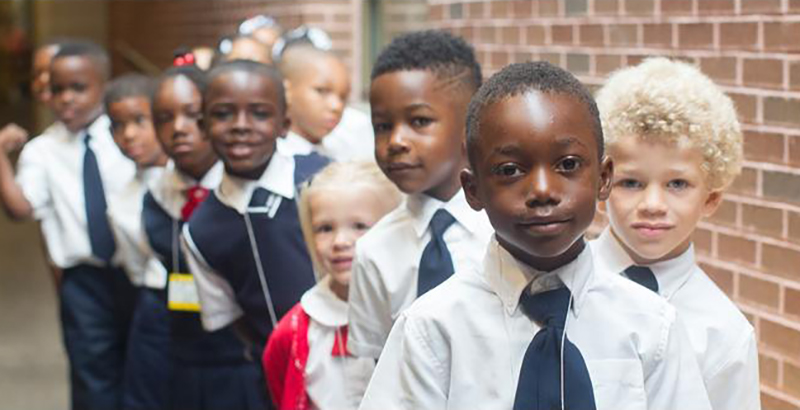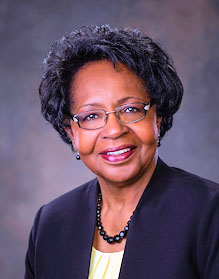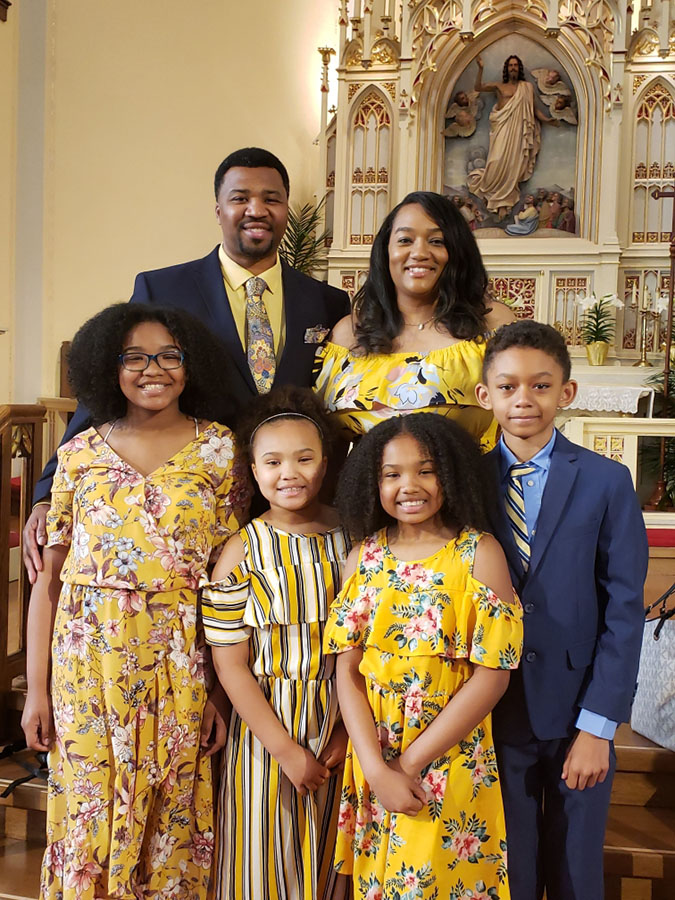‘You’re Debating Someone Else’s Child’: 30 Years Later, Milwaukee’s School Voucher Program Divides a City Whose Public Schools Struggle

Milwaukee
Ron Kelly saw a crowd of protesters as he turned into the parking lot to drop off his daughters at St. Marcus Lutheran School.
Their signs read “Save our public schools” and “Public dollars for public schools.” Several people held up a yellow and green banner with a caricature of U.S. Secretary of Education Betsy DeVos, who was visiting the private school that September morning last year as part of a nationwide “Back-to-School Tour.” She didn’t plan to visit any of the city’s traditional public schools, and the protesters opposed her advocacy for market-based school reform.
Kelly, whose girls attend St. Marcus Lutheran with the assistance of tax dollars, didn’t talk to the protesters, but he wanted them to understand something.
“You’re debating someone else’s child,” he said.
America’s experiment with school choice started here three decades ago, when an unusual alliance formed between school reform advocates and black parents, helped by the political backing of a white Republican governor and a black Democratic state legislator. Together, they pushed for the creation of a school voucher program to help low-income children pay tuition at private schools. In its first year in 1990, fewer than 350 students participated. Small though it was, Milwaukee’s program was the start to redefining education in this country.
Programs in other areas soon followed, including Cleveland in 1995 and Florida in 1999. Because of the political divisiveness and legal questions swirling around school vouchers, Democrats threw their support behind charter schools, which are publicly funded but independently run.
Today, 43 states and the District of Columbia have charter schools. Sixteen states and the District of Columbia offer school vouchers, which provide public money directly to families to pay for private school tuition. Eighteen states provide tax-credit scholarships, which are like vouchers but are paid for by contributors who receive a tax break in exchange for giving money to the scholarship fund. Five states offer education savings accounts, which give parents tax dollars in an account for approved educational expenses.
The spread has provoked a fierce backlash from supporters of traditional public schools, who say such programs drain resources and children from an already underfunded public system. Ahead of the presidential election, prominent Democratic candidates have cooled on charter schools, a position that puts them at odds with many black and Hispanic families.
Some of those fault lines were evident when DeVos visited St. Marcus Lutheran. Most of the students going into school were black. Most of the protesters were white. Kellie Hayes, who was walking her daughter to school, noticed the racial divide.
“The protesters didn’t look like us,” she said.
Milwaukee’s voucher program arose from a history of segregation. Some parents were frustrated by under-resourced public schools in predominantly black neighborhoods and integration plans that put most of the burden on black students to travel to white schools.
Howard Fuller, one of the original proponents of Milwaukee’s voucher program, led an effort to create a new school district out of a cluster of predominantly black schools in the city. When that failed, he and others got behind the concept of school vouchers, which had been advocated for years by Milton Friedman, a conservative economist and Nobel Prize winner.
“For us, it was never a free-market issue. It was a social justice issue,” Fuller said.
Fuller, a former Milwaukee schools superintendent who founded a charter school and is a nationally known school choice advocate, drew criticism from other voucher proponents about a decade ago when he pushed for greater accountability for Milwaukee’s voucher schools. He said he was trying to preserve the program at a time when the governorship and state legislature were controlled by Democrats. Voucher schools now administer state standardized tests and report the results alongside public schools.
Despite those changes, the debate about school choice is as polarizing as ever in the city, perhaps even more so after years of declining enrollment in Milwaukee Public Schools. The school district now enrolls about 65,000 students in its traditional schools. The Milwaukee Parental Choice Program has grown to 28,978 students this school year. Other students attend charter schools or use open enrollment to enroll in schools outside Milwaukee.
“It’s been a bit of a political football over the last 30 years,” said Patrick Wolf, professor of education at the University of Arkansas, who has studied school choice programs, including Milwaukee’s.
School vouchers also haven’t driven widespread improvement in student achievement. In a five-year study of the program, students using school vouchers performed, on average, about the same as public school students, except for a small boost in reading scores for voucher students in the last year of the study. That year, voucher students were required to take state standardized tests and the results were released publicly. Researchers were unable to determine if the jump in reading achievement was related to the voucher program, the new testing requirements or a combination of the two, Wolf said.
Voucher students were, however, more likely to graduate from high school, enroll in college and finish their degree, he said.
Last spring, a slate of public-school advocates was elected to the school board, and the new board members face myriad challenges. Some schools are drastically under-enrolled. Parents also have complained about large class sizes and cuts to music and art programs.
At a school board meeting in January, comments from the public painted a dire picture.
Sue Pezanoski Browne, who has taught art in the school district for more than 20 years, moved to a middle school in 2011 after her position at an elementary school was cut. Many of the older students at the new school had never been in an art class before, she said. She has since returned to the elementary level.
Saniya Booker, a 16-year-old sophomore at Bradley Tech High School, said she has at least 40 students in one class.
“We can’t even take our books home because we don’t have enough,” she said.
Amy Mizialko, president of the Milwaukee Teachers’ Education Association, told board members that the school district hasn’t received enough money from the state, and financial problems have been “exacerbated by private charter schools and private voucher schools.”
Of the students, she said: “They’re asking you for their basic needs.”
District leaders plan to ask voters in April for $87 million in additional funding, money they say will be used to lower class sizes and restore arts programs. Even if it passes, Milwaukee Public Schools Superintendent Keith Posley said it won’t be enough. “It will not solve all of our problems,” he said.
Milwaukee’s school vouchers will cost about $230 million this year, primarily from state dollars. The school district will contribute about $37 million to that total.
At St. Marcus Lutheran, Superintendent Henry Tyson takes issue with the idea that his school has hurt the public schools. He has a map on a wall with the locations and test scores of about a dozen nearby schools. Most are public and most are low-performing. Two had zero students test proficient or better in reading last year, scores that he describes as “almost criminal.”
“The failure of a lot of these schools predates vouchers,” he said.

Marva Herndon, a retired computer programmer who won a seat on the board after years as a public school advocate, said the school district needs to do a better job of promoting its schools. A black woman who grew up in Milwaukee, she believes that an unintended consequence of past desegregation plans is that some black parents think their children need to leave their neighborhood schools to get a better education. Some black students were bused to predominantly white schools in the city or chose to attend white suburban schools through a voluntary integration program.
“That mindset hasn’t changed,” she said.
The school district also was caught up in a scandal last year when Michael Bonds, the former president of the school board, was convicted in federal court of taking bribes from a Philadelphia-based charter school company in exchange for votes that helped it renew and expand contracts despite financial concerns. The company, Universal Cos., opened three schools in leased public school buildings and took about $11 million in public dollars before abruptly closing the schools midyear. Bonds hasn’t been sentenced yet.
Herndon became concerned about school vouchers about a decade ago after she saw new charter and voucher schools opening in “dilapidated buildings, factories and garages.” She successfully pushed for a city ordinance in 2012 that required that new elementary schools have access to a playground.
She also wants to start collecting better data to show how many students leave voucher schools and charter schools after enrollment counts that determine school funding. She suspects some are pushed out afterward.
“It becomes a moneymaking venture,” she said.
For many of Milwaukee’s parents, the politics of school choice have little to do with the day-to-day decisions they’re making about their children’s education.
Hayes, who walked by the protesters at St. Marcus Lutheran last fall, said her daughter attended a high-performing public Montessori school before enrolling at the private Christian school. The public school offered chess, art and Spanish. But when she moved to a new neighborhood, she needed a school within walking distance.
“This was the closest school to us,” she said of St. Marcus Lutheran. “It was a blessing and a surprise.”
Jiquinna Cohen sent her three children to St. Marcus Lutheran with school vouchers. Her oldest daughter graduated from a Lutheran high school, but the younger two attend a public high school. Her son, Bakari Cohen, wanted to go to a more diverse school, she said, and her youngest daughter followed him there.

Kelly, who has three daughters at St. Marcus Lutheran, said his mother sent him to predominantly white schools outside Milwaukee through the voluntary integration program. When it came time to select a school for his daughters, Kelly said he didn’t have a good opinion of city schools and he didn’t want them to ride a bus outside the city like he did. School vouchers allowed him to look for what he wanted, a faith-based school with structure and discipline.
“A public school was never an option,” he said.
Cara Fitzpatrick is a former reporter for the Tampa Bay Times. She is currently writing a book on the history of school choice due out in 2021.
Get stories like these delivered straight to your inbox. Sign up for The 74 Newsletter

;)